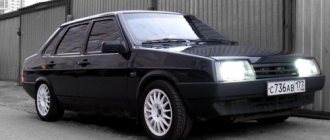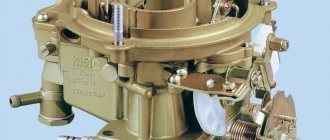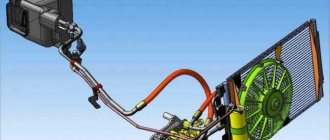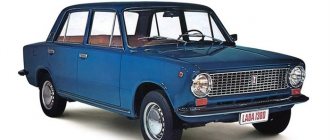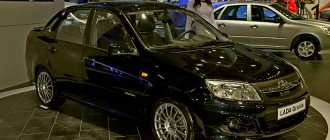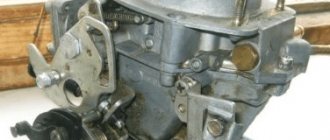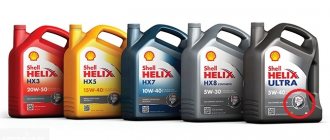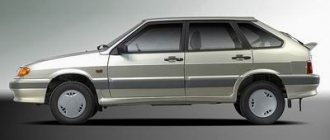VAZ-2109 is a compact car that has been on the assembly line since 1987. It is a five-door hatchback, built on the basis of the three-door version of the VAZ-2108. Also from this line there is a modification of the VAZ-21099 in the body of a four-door sedan. However, the VAZ-2109 is recognized as one of the most popular in the family. The successor of this car is considered to be the VAZ-2114 model of 2001. As for the VAZ-2109, this car was produced until 2004 at the Volzhsky Automobile Plant. From 2004 to 2011, the car was produced by Ukrainian. This model is notable for being the first front-wheel drive AvtoVAZ car after the VAZ-2108. The car was delivered abroad. Thus, the version for Finland was available with air conditioning, electric windows, power steering and a sunroof.
VAZ 2109 in detail about fuel consumption
Among the quality technical characteristics of any car, an important place is occupied by how many liters of fuel it uses. That is why car enthusiasts were struck by the indicator describing the fuel consumption of the VAZ 2109, developed in 1987. The paradox is that an SUV is distinguished by its reliability, ease of maintenance and operation, but surprises with its inefficiency. We will try to explore the reasons for this situation and the significance of the fuel supply system for it.
Data sheet consumption values for modifications 2109
During the production history of the Lada Nine, it was produced with five types of eight-valve engines, which differ slightly in terms of fuel consumption. Below are the engine models and their rated values for gasoline consumption per 100 km on a combined cycle.
Injection engines straight from the VAZ 2109 factory have higher fuel consumption than carburetor engines. But during operation, the fuel consumption of an injection engine does not increase as much as that of a carburetor engine, so we will not consider the fuel consumption of the VAZ 2109 injector in detail. Let us dwell on the reasons that often cause increased fuel consumption on modifications of the Lada Samara with a carburetor.
With timely troubleshooting of problems that affect overconsumption and proper driving of the car, you can achieve optimal gasoline costs.
Gasoline consumption indicators
First, it would be advisable to determine how the VAZ 2109 gasoline consumption per 100 km changes, depending on the type of liquid. Let us note the following indicators:
- With A-76 - 0.60 l.
- With A-80 - 10.1 liters.
- With A-92 - 9.0 liters.
- With A-95 - 9.25 liters.
- With A-95 Premium - 8.4 liters.
- When using propane or butane - 10.1 liters.
| Engine | Consumption (highway) | Consumption (city) | Consumption (mixed cycle) |
| 1.1 | 7.9 l/100 km | — | — |
| 1.3 73 hp | 7 l/100 km | — | — |
| 1.5 68 hp | 5.7 | 8.7 | 7.7 |
| 1.5i 79 hp | 5.7 | 9.9 | 7.7 |
| 1.6 | 5.6 | 9.1 | 7.7 |
| 1.3 140 hp | 7 | 12.5 | 10 |
FIREBALL 02/27/2010, 21:05
I have long noticed that gasoline is somehow quickly consumed. I measured the consumption (the tank of the 99 seems to be exactly 40 liters). It turned out to be 15 liters per hundred, taking into account the fact that during this hundred I sit in the yard in a car with the engine running for about 2-2.5 hours. Based on the calculation that about a liter per hour is consumed at idle, then the consumption per hundred without “get-togethers” is approximately 13 liters. As far as I know, according to the passport it should be from 7 to 10 liters per hundred, depending on driving. When I was at the service center I also checked the CO-CH. They said that they were normal. The spark plugs are now iridium, I measured them with them. There shouldn't be any problems with combustion. When I did the diagnostics in the summer, they said it was very good. old firmware. Perhaps that's the problem. A friend has a VAZ-2108 with the same engine. Consumption is 8-9 liters per hundred.
What could be the problem?
PS: A friend gave me a ProSport zero-resistance filter today. I set it for myself, fuel consumption, they say, with them increases, but not by much. I took measurements without it.
Reasons for increased costs
There are a number of factors that determine the fuel consumption of a UAZ. They can be divided into three groups, among which are those that depend on the owner himself, the faulty technical condition of the parts or the type of flammable liquid. The influence of the last factor has already been mentioned, so we will focus on others.
The car is not working properly
The average gasoline consumption of the VAZ 2109 per 100 km is significantly influenced by the factors of incorrect carburetor settings, stuck needle and fuel pump (increase by an average of 4 liters). An insufficiently warmed up engine increases consumption by another one and a half liters.
Driving method of VAZ owner
The fuel consumption of 2109 per 100 km is also affected by the owner’s driving style - the higher the speed of the SUV, the greater the volume of liquid leaving the tank. When you turn on the headlights, the overall consumption rate increases by 10 percent, and flat VAZ tires have the same effect.
When installing a trailer, gasoline consumption increases by another 60 percent.
Using fuel with a VAZ carburetor
The amount of substance used depends directly on how the modification of a number of UAZ cars works - on a carburetor or on an injector. First, let’s determine the fuel consumption of the VAZ 2109 carburetor, since it is believed that this type of system has the highest consumption:
- 2109 fuel costs in the city are 8-9 liters per 100 km;
- gasoline costs on the highway - 6-7 liters per 100 km, at a speed of 90 km/h;
- gasoline costs on the highway are 7-8 liters per 100 km, at a speed of 120 km/h.
Malfunction of valves or flaps in a VAZ
One of the main factors in increasing the indicator is a closed or not fully open air damper. You should always check whether it is in the correct position - the handle is facing the owner, and the part itself is in a vertical position. The same problem with an improperly closed solenoid valve or fuel nozzle leads to increased fuel costs for VAZ.
If the sealed mode of the needle valve is violated, excess portions of liquid enter the cylinders.
Problems with EPHH
If the XX system jets have a diameter that is too large, then too concentrated, supersaturated oil will enter the combustion chamber. Their contamination also causes increased consumption and requires immediate cleaning. An even more important factor is the breakdown of the forced idle economizer, which requires immediate repair.
How to drive Lada 2109 economically
Identifying breakdowns using the consumed displacement is very useful, but more often we are faced with another question: how to improve your driving so that as little fuel as possible is wasted. Indeed, if the car is in full working order, up to 50% of fuel consumption is due to driving style.
The most optimal driving style for low consumption is a smooth, measured movement. There is no need to accelerate or brake suddenly. You need to maintain the speed at 2500 rpm. In the summer, when driving down a mountain or simply accelerating the car, you can turn on neutral gear and roll at idle speed. During such a movement, the consumption of the VAZ 2109 is close to zero.
The level of tire pressure significantly affects the number of liters of gasoline consumed. The pressure in the wheels of the Lada Samara must be at least 2 atmospheres on the front axle and at least 1.9 atmospheres. - on the rear. Without pumping up the tires, you can waste up to 10% of additional fuel.
We must not forget in the cold season that the car has a carburetor. And the carburetor design involves warming up the engine before driving in cold weather. If you immediately start the engine and set off, the engine will immediately not be able to work at full power, and you will put full pressure on the pedal. In order for the engine to be “pulled” into operation, it will need to “suck in” additional fuel. This can account for up to 20% of overruns.
Additional fuel consumption of the VAZ 2109 carburetor appears when driving with the headlights on. Headlights are a consumer of electric current, the generator needs to generate additional charge, and it becomes harder for the motor to rotate the generator. This results in increased consumption. And this applies not only to headlights.
Electricity consumers require fuel when driving. Consumption is also affected by headwinds, vehicle overload and the quality of the fuel used.
Overconsumption when equipped with an injector
It is worth noting that when changing the fuel supply system, the excess use of gasoline is not less, but has a number of other reasons. Therefore, the fuel consumption of the VAZ 2109 injector corresponds to these indicators
:
- fuel consumption in the city is 7-8 liters per 100 km
- Gasoline consumption standards for the Lada 2109 on the highway are 5-6 liters per 100 km, at a speed of 90 km/h
- fuel consumption on the highway at a speed of 120 km/h - 8-9 liters per 100 km
Failure in the VAZ control system
Any interruptions in the electronic equipment of the car lead to the fact that the real fuel consumption on the injection VAZ 2109 is growing rapidly. If the temperature, oxygen, or mass air flow sensors do not work correctly, the electronic control unit cannot adequately respond to changes. This provokes a sharp deterioration in the fuel situation.
Reduced pressure and injector failure in a VAZ
A decrease in pressure in the fuel system leads to an immediate decrease in the power of a VAZ vehicle, which increases the period of engine operation at high speeds. Damage to the injector itself immediately increases fuel consumption. To avoid this, you need to periodically clean the injectors.
Source
Setting the ignition timing
When the ignition timing is correctly set, all indicators of engine performance (reactivity, power, idling, energy consumption) are within normal limits. To carry out the work, you must have a strobe and a tachometer, an open-end or socket wrench of 10. In general terms, the setup is done as follows:
- The engine warms up to operating temperature. Low idle speeds are set by ear or on the tachometer (less than 800 rpm), after which the engine is turned off.
- On the gearbox housing, look for a hatch with a visible part of the flywheel and a scale. Most often it is closed with a rubber stopper that needs to be removed.
Problem: high fuel consumption VAZ-21093i
Hello, dear car enthusiasts. I finally decided on a problem that worries me greatly. VAZ-21093i 2002 recently purchased (still just getting used to it) mileage 107t. Refueling a full tank (42-44l) is enough for 250-300 km! Although judging by the parameters it should be about 500 km. I drive both around the city and on the highway, so I can’t blame traffic jams, etc. At the moment there are several suspicions, I ask you to share the experience of those who have encountered this: 1. The sensor on the air filter is filled with antifreeze that once leaked. Could this be due to improper air pumping and flow? 2. At the junction of the top engine cover with the cylinder block, a slight deposit of oil is visible. Does this mean that there may be a compression failure due to the gasket and an increase in consumption? or is this a problem from another story? 3. Is it possible that improper operation of the injector will affect the flow rate? I want to do diagnostics, despite the fact that there are no problems with the nature of the engine’s operation at all.
Fuel consumption VAZ 21093
Onion rings stuck between car seats don't smell better over time.
Model 21093 has the only difference from the base model - an increased engine capacity. Everything else is no different from the usual nine. The release of this version began a year after the start of production of the regular VAZ 2109 - in 1988. Models no longer come off production lines at the same time.
Transmission and chassis of the VAZ 21093
The transmission on the VAZ 21093 is structurally made of one unit, including a clutch and a manual gearbox (MT). The gearbox is combined with a differential, the clutch is single-plate. The clutch housing is connected to the flywheel with bolts. To ensure contact with the pressure plate, six elastic plates are used. The gearbox is manual, five-speed. The input shaft gears are constantly meshed with the driven gears. The secondary shaft has two synchronizers.
The car's wheel drive includes two constant velocity joints (CV joints): a rod shaft on the left and a tubular shaft on the right. The front suspension of the car is independent, hydraulic shock absorbers, cylindrical springs. The rear suspension is torsion bar, independent, with a trailing arm design.
The braking system on the 21093 uses front disc brakes and rear drum brakes. There is a diagonal interaction of contours. One circuit includes the right front and left rear wheels, the other - the remaining two. The hydraulic drive of the system includes a vacuum booster and a pressure regulator for the rear brakes.
Owner reviews
“An excellent car, especially for Russian roads. In appearance, the car seems small, but inside there is a lot of space for both passengers and various cargo. I use the car mainly for work: during the day I deliver goods to stores, and in the evenings I work part-time as a taxi driver. The car performs well in both directions. The interior is quite comfortable, the seating is comfortable, but the equipment is rather weak even on a model released in the 21st century. Everything is assembled with high quality, reliably, for many years to come, but there is practically no sound insulation. On the one hand, this is a plus, since you can enjoy the sound of the engine when driving along the highway, but it quickly gets boring. I plan to solve this problem soon. In the city there are no particular problems in using it, since the car has good handling, and the whole suspension as a whole. But I was unlucky with one. My car has high consumption, although others do not have such problems. I spend about 10 liters,” writes Valery from Ufa.
“This is my first car after getting my license. I don’t really like it in stock, but I plan to make it for myself. I'll paint it and make body kits. The salon is still more or less here, but I’ll also create something. I’ll re-sew it into leather, the tidy into Alcantara, and I’ll assemble everything better. Since I plan to drive fast, I will also do some work on the engine. Stock is very weak for its volume. But the gas mileage is very decent, even on par with foreign cars. I have never had to spend more than 9 liters in the city, although I drive often and quickly,” Alexander from Voronezh left this review about the car.
“My father gave me this car. He bought a foreign car for himself, saying that I should gain experience in driving a domestic car. Once you learn how to drive it, you can drive anything. At first, the controls seemed very difficult to me, since there was nothing at all that would make driving easier. But then I got used to it, and even began to like it. The car is very decent, well suited for the city. There is a lot of space inside, it is comfortable to sit. The only bad thing is that over time this engine has become too weak for me, because I want to go on the track and enjoy the speed. But it has a low consumption, which is only 8 liters,” wrote Maxim from Kaliningrad.
“Many friends advised me to take a nine, but not a simple one, but with a larger engine, since it is much better in everything. But somehow I didn’t particularly like her. I was hoping for something more comfortable and technologically advanced. The car was produced in 2000, and it is equipped with technologies from the eighties. The engine is frankly weak, it barely pulls for its volume. I am glad that at least it consumes little fuel, no more than 9 liters. Perhaps, if various modifications are made, the car will give a pleasant driving experience, but so far this is not happening,” this is a review from Leonid from Lipetsk.
“I bought an improved nine secondhand, because I had long wanted to take it, but as a second car. I plan to carry out a number of various improvements with it and travel to exhibitions, since such cars are very popular. I want to leave only the body from stock, and I’ll wrap that as best I can so that only the outlines are recognizable. For now I drive stock, because I need to earn money for all this. The car itself is not bad, but I couldn’t drive it all the time. The level of comfort is minimal, and the engine is not up to par with foreign competitors. But there is a pleasant bonus - fuel consumption does not exceed 9 liters,” wrote Dmitry from Krasnodar.
“Over the years I have driven many of our cars, but I decided to stop at the VAZ 21093. I always liked the Nine, and here is also a version with a large engine, which shows quite tolerable speed and acceleration. In terms of comfort, the car is no better than previous models and is clearly one step lower than foreign cars, but the sensations and adrenaline from driving cannot be expressed in words. I don’t plan to change the car for another one, since I simply can’t find such an indicator of consumption in the city for this price. My average is 8 liters,” this is a review from Pavel from Yekaterinburg.
Source
VAZ 2109 1.1 53 hp
Fuel consumption rate per 100 km
This is the weakest version in the entire line of engines. The start of sales of this modification (VAZ 21091) took place in 1987. But this particular installation was not widely used and was discontinued in 1997. The hatchback itself has front-wheel drive and only a manual transmission. The power supply system is a carburetor. The only plus in this variation is consumption: in the city - 8.2 liters, and on the highway - 5.4 liters. Maximum acceleration is up to 139 km per hour. Acceleration to hundreds is carried out in 17 seconds.
Fuel consumption on Russian roads
- Pavel, Gorodets. It is difficult to measure consumption on a 1991 “nine” with a 1.1 liter engine. Not a hint of the on-board computer. I understand that I came across a real exotic, but for a novice student driver this is the only available option for now. I won’t say that a glass of gasoline is enough for her, but the approximate consumption is within 8-9 liters in the city.
- Sergey, Vyborg. I was able to withstand only one year on the 1.1-liter version of the “nine” produced in 1992. Well, the car doesn’t pull along the highway at all. It feels like it was made for grandfathers who can handle 40 km/h. By the way, the consumption of the VAZ 21091 is no less than that of the same model with a one and a half liter engine. On average 9 liters per 100 km in the combined cycle.
- Artem, Elista. For a summer resident, like I am, the main thing is to deliver garden tools and all rubbish safe and sound. So my nine is 1.1 liter. I don't regret 1989. It can withstand speeds of 100 km/h. Moreover, 20 liters is enough for two full trips (a total of 370 km).
- Alexander, St. Petersburg. My VAZ 21091 1.1l. 1992 - the car is clearly not for the track and long trips. The engine strains a lot when you try to reach a cruising speed of 120 km/h. In the city, the differences with the 1.5 version are almost imperceptible, both in terms of consumption (8.5-9.0 liters) and dynamics. That is, if you move 60 km/h, then there are no complaints about such a motor.
- Sergey, Ufa. Some kind of defective 1.1 liter version. I got my hands on a 1993 Nine with just such an engine. Neither accelerate normally nor move off. I thought maybe the consumption would be minimal. I was mistaken, it consumes the same engine as a regular model with a basic 1.5-liter engine (city - 8 liters per 100 km, highway - 6 liters).
Fuel consumption on the VAZ-2109
In the second half of the 80s. last century, fuel consumption on the VAZ-2109 met international requirements for efficiency. The plant offered several modifications of carburetor engines, differing in displacement, power and fuel consumption. Later, options appeared with gasoline injection systems, which made it possible to reduce the toxicity of exhaust gases.
Solex carburetor. How to reduce consumption by selecting jets
Fuel consumption on Lada Vesta
This is a fairly simple and effective way to increase the efficiency of a gasoline engine. The essence of the method is to select fuel jets for the main dosing system. The jet is selected only for the first chamber and the idle system is adjusted.
- The engine warms up to operating temperature (about 90 degrees).
- A bottle of gasoline is installed under the hood. The suction fitting of the fuel pump is disconnected from the fuel hose and connected to the bottle with another hose.
- A control section is driven through at an optimal speed of 60-70 km/h and the fuel level in the bottle is measured.
- The carburetor cover is removed, the jet is changed to another, smaller cross-section (for example, 107.5 to 105). After this, the used fuel is measured again at the control section. At the same time, the dynamics of the car and the appearance of dips when pressing the accelerator are carefully monitored.
- In a normal situation, you can change the jet to an even smaller one. When failures occur, the experiments are stopped. After this, the idle speed is adjusted.
- The idle fuel jet is changed to a similar one, but with a larger cross-section (for example, 40 to 42), the speed is adjusted, and a test run is performed.
- If, as a result of the adjustment, the dips disappear, the adjustment was successful; if not, the idle jet is changed to an increased one and the race is carried out again.
The result of all these manipulations should be stable operation of the engine at idle, no dip in the gas pedal when starting and driving. The main result is a reduction in fuel costs.
Description and technical characteristics of the VAZ-2109 car
Cars with a 5-door hatchback body began to be produced in 1987. Initially, the plant offered versions with 1.3 and 1.5 liter carburetor engines for the domestic market, and a model with a 1.1 liter engine was assembled for export. In the early 90s, the body and interior were modernized, and already in 1995 the first commercial samples appeared with a 1.5 liter gasoline unit with a GM injection system. Car production continued until 2011 (in Ukraine), and the equipment was equipped with an 8-valve VAZ-11183 engine with a displacement increased to 1.6 liters.
A torsion beam with shock absorbers and drum brakes was used at the rear (discs at the front). Panels molded from plastic were widely used in interior decoration. The vehicle is equipped with rack and pinion steering (no power assist).
Brief technical characteristics of the VAZ-2109:
- body length - 4006 mm;
- width without mirrors - 1650 mm;
- height (on standard tires 165/70R13) - 1402 mm;
- ground clearance - 165 mm;
- wheelbase - 2460 mm;
- curb weight - 945 kg;
- load capacity - 425 kg.
Consumption of VAZ 21099 with carburetor
Initially, the car was equipped with several modifications of gasoline engines of various designs and volumes. The most affordable was the 1.3 engine with 64 horsepower. It, like other versions of the car, was equipped with a five-speed manual transmission with front-wheel drive. The car accelerated to hundreds in 14.5 seconds with a top speed of 140 km/h. With a carburetor fuel supply system, the fuel consumption of this engine was:
- city 9.1 l;
- average 7.7 l;
- on the highway 5.7 liters.
A rotary version of the engine of the same volume with 135 horsepower was offered, but it was supplied to special services and for export. The installation of this power unit improved the dynamics, but at the same time fuel consumption increased:
- in city mode 12.5 l:
- in a mixed cycle 10 l;
- on a free road 7 l.
The most popular was the 1.5 engine with 70 horsepower; it was distinguished by its reliability, accelerating the car to 150 km/h, and to the first hundred in 14 seconds. It is fueled with AI 92 or AI 95 with fuel consumption similar to the less powerful version:
- in traffic 9.1 l;
- on average 7.7 l;
- on the highway 5.5 l.
Actual fuel consumption depending on engine type
In addition to cars with a standard body, in 1995-99. A Baltic modification was assembled in Finland, which differed in the design of the interior, front and rear. All assembled hatchbacks were equipped with a 1.5-liter VAZ-2111 engine. Fuel consumption did not differ from that of its Russian counterparts. The table shows the engine models and the efficiency characteristics declared by the AvtoVAZ plant (in liters per 100 km).
Most of the hatchbacks built were used by the Ministry of Internal Affairs. Cars are periodically found on the secondary market.
Real fuel consumption per 100 kilometers
During the operation of the equipment, drivers note a deviation in fuel consumption in a larger direction compared to the factory data. When carrying out certification, the manufacturer takes measurements at the test site, creating the most comfortable conditions. The cars are driven by experienced testers, who are tasked with achieving minimal gasoline consumption while simulating various operating conditions.
Injector
The use of a distributed injection system made it possible to smoothly regulate the composition of the fuel-air mixture depending on the load and temperature of the cooling system. As a result, exhaust toxicity dropped, but gasoline consumption remained the same. A 1.5 liter engine burns up to 10 liters of fuel in urban conditions, and on the highway the car needs 6.5-7 liters of fuel at speeds of up to 110 km/h. The modification with a 1.6-liter unit is characterized by increased gasoline costs in populated areas (up to 11 liters in winter or in heavy traffic jams).
Reducing fuel consumption of a car with carburetor 2108, 21081, 21083 Solex
This article outlines the simplest, but no less effective way to improve the fuel efficiency of a passenger car (VAZ 2108, 2109, 21099) with a carburetor engine (Carburetors 2108, 21081, 21083 Solex). This is a method for selecting fuel jets for the main metering system. Moreover, it is only necessary to select the fuel nozzle of the first chamber and configure the idle system. We don't touch the second camera at all. It should be noted that such carburetor tuning leads to a reduction in fuel consumption without noticeable losses in throttle response and power, adapting its parameters to the needs of this particular engine.
If your car’s engine “troubles”, emits clouds of black smoke, etc., then most likely you can achieve fuel economy only by overhauling it. The degree of wear can be determined by measuring the compression in the cylinders. If everything is more or less in order, we will perform several necessary procedures and begin setting up the carburetor for economical operation.
2. We check and adjust the main systems and mechanisms of the engine.
— check the spark plugs and adjust the gaps in them;
— we check the serviceability of high-voltage wires, ignition coil, distributor (2108);
— if necessary, adjust the clearances in the valve mechanism;
- Replace the air filter with a new one.
3. We clean and clean the carburetor, both external and internal. We adjust the basic parameters of the carburetor.
4. We check other systems and mechanisms of our car. You can use the article “Increased fuel consumption” for this.
5. We are looking for a more or less deserted section of the road, 3-4 km long.
6. Prepare a one and a half to two liter plastic bottle for gasoline; you can mark it in advance at 100 ml.
7. We stock up on fuel jets for the main metering system in advance. For the first chamber of the carburetor, a smaller cross-section than what you have installed and idle fuel jets (they are inserted into the solenoid valve or a plug that replaces it), on the contrary, have a larger cross-section than the existing ones. You can see what cross-section of jets are installed on your carburetor in the section “Calibration data and parameters of carburetors 2108, 21081, 21083 Solex and 2105, 2107 Ozone” in articles on calibration data.
Setting the carburetor 2108, 21081, 21083 Solex for minimum fuel consumption
1. Warm up the engine to operating temperature (85-90 0 ).
2. Remove the fuel hose from the suction fitting of the fuel pump. We connect this fitting with another hose to a bottle filled with gasoline and installed in the engine compartment of the car.
3. We drive our pre-selected section of 3 km at a speed of 60-70 km/h and see how much the level of gasoline in the bottle has dropped. This will be a control measurement.
4. Remove the carburetor cover and change the fuel jet of the main metering system to the same one, but with a smaller cross-section. For example, “107.5” is changed to “105”.
5. We drive through the control section and check the fuel consumption per bottle
At the same time, we pay attention to the dynamics and the appearance of dips when you press the gas pedal. If everything is in order, change the fuel jet to a smaller one again and carry out a test run again
6. If a “failure” appears when you press the gas pedal, stop experimenting with selecting a fuel nozzle and begin adjusting the idle speed.
7. We change the idle fuel jet to the same one but with a larger cross-section (for example, “40” to “42”), adjust the idle speed and carry out a test run.
The dips are gone - the adjustment was successful, no - we change the fuel jet of the idle system to a larger one and carry out the race again.
As a result of this selection of jets, we achieve stable engine operation at idle, no “failure” when pressing the gas pedal when starting from a stop, while driving, and most importantly, a slight decrease in the engine’s fuel appetite.
Five more articles on the site on carburetor tuning
Ignition fault
Consumption may also increase due to incorrect ignition adjustment. If the setting is off and the ignition is too early or too late, the consumption of the combustible mixture will be higher than normal. To do this, you need to conjure with the position of the distributor, turning it while checking the marks on the body. The technical literature of the model indicates the correct ignition timing for a given engine and, guided by this, you can safely make adjustments. After completing the adjustment, you need to perform a check. To do this, accelerate the car to a speed of 45 - 55 km/h and sharply press the gas pedal. In this case, a detonation effect should appear for a short time.
Reasons for increased costs
Owners of VAZ-2109 cars may experience a sudden increase in fuel consumption resulting from breakdown or improper adjustment of power unit components. It should be noted that in winter and in heavy traffic jams, gasoline costs may temporarily increase by 10-15%, which is not a sign of a malfunction. The systems must be checked at a steadily increasing flow rate, regardless of the driving mode and interior load.
The car is not working properly
Engine efficiency is negatively affected by incorrect adjustment of the ignition system and carburetor (the problem does not apply to engines with an injector equipped with an electronic control unit). Incorrectly configured wheel bearings or poorly aligned front wheel alignment angles contribute to deterioration in handling and lead to an increase in consumption by 1-2 liters.
An additional negative impact is caused by worn piston parts or a jammed cooling system thermostat.
Driving style
Fuel costs also depend on driving style and operating conditions. Drivers who rev the engine to maximum speed and drive in low gears receive city consumption of 11-11.5 liters. On the highway, when accelerating to 120-130 km/h, the engine burns 8-9 liters of fuel. If the car is operated with a trailer or roof rack, then the engine will require additional fuel (from 1 to 2 liters depending on the mode of travel).
Malfunction of valves or dampers
On carburetor engines, fuel consumption is affected by the correct throttle valve adjustment and the serviceability of the solenoid valves. Incorrectly configured fuel mixture supply equipment worsens dynamics, makes it difficult to start the engine and increases gasoline costs by 5-10%. Owners are recommended to periodically check the correct operation of the carburetor and adjust the main components.
Problems with EPHH
By default, engine carburetors on the VAZ-2109 were equipped with a forced idle economizer (EFI), which made it possible to reduce fuel consumption and reduce exhaust toxicity. The system included a solenoid valve, which operated based on a signal from the controller and a switch located on the throttle valve drive axis. If the EPH components malfunction, fuel consumption increases.
Failures in the control system
On cars with a distributed injection system, fuel consumption increases when the sensors break down or the wiring harnesses are damaged. The driver receives a signal about any malfunctions via the Check Engine warning lamp installed in the instrument cluster. To determine the faulty unit, a diagnostic computer is used, which is connected to a special connector.
Reduced pressure and injector failure
On injection power systems, fuel is supplied by an electric pump. The pressure regulator located in the ramp dumps excess gasoline back into the tank. If a pump or valve breaks down, the normal operation of the engine is disrupted, which leads to an increase in fuel consumption. The efficiency is affected by the condition of the nozzle spray heads, which gradually become clogged with dirt and require cleaning in an ultrasonic bath.
Faulty electromagnetic injectors are detected during computer diagnostics.
How to reduce fuel consumption
Despite the efficiency of the VAZ 21099, there are often reviews of increased gasoline consumption. The most popular reason is the subjective factor. Driving too dynamically increases consumption by up to 50%. It is recommended to move off smoothly, change gears in a timely manner in the range of 2-3 thousand revolutions, and move on the highway at a speed of 90-100 km/h. There are other problems that, by eliminating them, can reduce fuel consumption on the VAZ 21099:
- Engine wear. If the compression in the cylinders drops below 8.5 atmospheres, a major overhaul is necessary; after running in, the engine's appetite will decrease.
- Pressure in the slopes. The manufacturer recommends 2 atmospheres. A decrease in pressure is especially harmful; the car begins to “float” on the road, and consumption increases.
- Open windows at high speeds increase consumption by 1.5 liters, the turned on air conditioner takes 1 liter per hundred, so it is better to use it on long trips.
- There is no need to overload the car with tools and other items.
- Periodically adjust the carburetor and clean the injector; they become clogged, the quality of the mixture is impaired, which leads to overspending. If you don't pay attention to this, the car will simply break down.
Effective Fuel Saving Techniques
To reduce fuel costs you need to:
- maintain the good condition of the power unit;
- control the operation of brake mechanisms and wheel bearings;
- do not install additional elements on the body that increase resistance;
- check and adjust tire pressure;
- do not travel at speeds exceeding 100 km/h and avoid driving with the windows open;
- refrain from traveling short distances at sub-zero temperatures;
- Avoid overloading the vehicle and avoiding prolonged driving in low gears.
Setting up injectors on professional equipment
Everything depends on the serviceability of the fuel injector in injection systems. The engine will operate properly and without problems only if the injectors are in good working order and accurately adjusted. Even a minimal inversion of the performance of one of the injectors will affect the capabilities of the engine and its dynamics. And periodic operation of a machine with such nozzles will ultimately lead to expensive repairs of the internal combustion engine.
To adjust the injectors you will need bench equipment. Special tools are also needed. Due to the lack of such equipment in the garage, it is customary to entrust the work of setting up injectors to specialists in a car service center.
Here's how the adjustment is made.
- The technician at the stand checks the nozzles, determines the tightness, and the degree of pressure at the moment the nozzle needle moves. If it notices discrepancies with standard parameters, it begins the adjustment process.
- The required pressure is set by rotating the screw with a lock nut, which is responsible for raising the locking needle. This type of adjustment is called smooth adjustment. But stepwise pressure adjustment involves the use of washers with different thicknesses.
- The degree and angle of fuel spray is adjustable. If the quality of the atomized fuel cannot be normalized, the atomizer is replaced.
